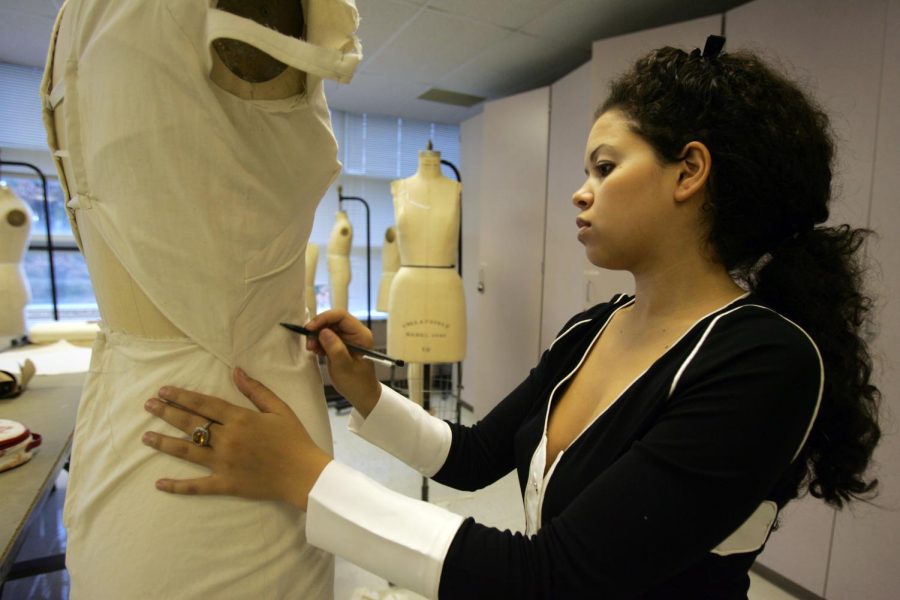Kent State’s fashion school holds its own
Photo Courtesy of TNS: Jocelyn Simms, a senior design student at the Fashion School at Kent State University and who attended the campus extension in New York last year, works on her senior project in Kent, Ohio, Friday, October 20, 2006. (Lew Stamp/Akron Beacon Journal/MCT)
November 22, 2015
Kent State’s Fashion School sees a high increase in enrollment this year.
According to Kent State’s Institutional Research, the College of the Arts, which is largely made up of fashion school students, saw a 4.27 percent increase in undergraduate enrollment from 2014 to 2015.
Over the years, the Fashion School has been slowly securing its place as one of the top fashion programs in the nation. Fashionista, a fashion news site, ranked Kent State’s Fashion School 22 in its article “The Top 50 Fashion Schools in the World: 2014 Edition.” Another top program, Savannah College of Art and Design, ranked 11.
According to Kent State and Savannah College of Art and Design’s (SCAD) public admissions records, Kent State fashion students make up about 2.7 percent of total university enrollment, while SCAD fashion students make up about 6.2 percent. But, the two programs differ on more than total fashion student enrollment.
According to public tuition records for both institutions, the price of enrollment at Kent State’s Fashion School for in-state students is $20,346 and $28,546 for out-of-state students. At SCAD, the tuition is held constant at $34,470 for both in-state and out-of-state students.
Kent State University is a public institution that runs on a semester term schedule, while Savannah College of Art and Design is private and runs on a quarterly term schedule. Kendle Meacham, a sophomore fibers major at SCAD, said that although taking three classes per quarter may not seem like a lot, her coursework still totals 15 credit hours.
“I really like this system because the courses are shorter and you get the chance to take all new classes three times a year,” Meacham said. “For me, it just works really well and makes breaks seem more natural.”
Contrarily, Makayla Staaf, a Kent State sophomore fashion merchandising major, said she was not aware other schools operated on a quarterly system, but she prefers the semester schedule regardless.
“I think semesters work well for me because you can get really in-depth with specific courses the longer you’re in the class,” Staaf said. “I feel like you learn more that way.”
Along with differing academic terms, fashion students at each institution might experience different student-to-teacher ratios in the classroom. Meacham said each class at SCAD has no more than 30 students, while Kent State’s Fashion School class size is dependent on class standing. Staaf said her classes are filled with at least 100 people, and only her lab courses have less than 20 students.
But, Jaanai Jones, a Kent State junior fashion design major, said large lecture courses happen mostly during freshman year. He said each of his classes now comprise of 16 to 17 students.
However, whether a student studies at Kent State or SCAD, they will have one thing in common: senior projects. Meacham said each senior fashion major creates a collection in hopes of being picked to be in the SCAD senior fashion show.
Kent State fashion seniors have a similar project if they choose to work toward the Fashion Design BFA. A portion of the BFA curriculum involves a senior thesis and a collection of nine to 12 garments that are judged and potentially shown in the annual spring fashion show.
“The fashion show is both beneficial and stressful,” Jones said. “It’s a lot of work, but it is good because it showcases what we can do and what we want to do after school.”
Similarly, spending a large amount of time outside of class on homework and projects is comparable for both Kent State and SCAD fashion students. Carly Zesiger, a production design student at SCAD, said she usually spends 60 hours a week on schoolwork outside of class.
“Typically, students spend at least 50 hours outside of class on work,” Zesiger said. “SCAD is a challenging school, but that challenge is what makes SCAD alumni so desirable to employers.”
Gina Lytz a Kent State junior fashion deign student, echoed that sentiment and said she spends around 50 hours per week outside of class on work. Lytz said the workload increases from sophomore to junior year due to an increase in projects.
“We aren’t sweating bullets every single day, but we are constantly working on our projects,” Lytz said. “It’s a full-time job outside of class.”
Whether studying fashion at Kent State or SCAD, one thing is certain: Being a fashion student requires passion.
Felicia Guadagni is the fashion reporter for The Kent Stater. Contact her at [email protected].

























